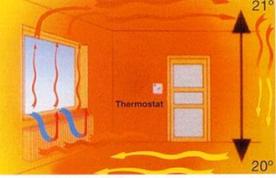If you need help and advice with regard to building surveys, structural surveys, structural reports, engineers reports, specific defects report, dilapidations or any other property matters please free phone 0800 298 5424.
How does the air move in your house?
Have you ever thought about how the air moves around your house and how this can be used to best advantage with regard to heating bills during the winter and coolness during the summer?
The basics of air is that warm air rises so for example a radiator located underneath the window when the warm air rises it hits the cool air from the window which will always be cooler than the wall itself and cause the air to circulate around the room. Particularly if the window is an older timber window which will have natural gaps or a modern plastic window with trickle vents which allow a trickle of air through.

A radiator placed on an internal wall, as is often the case as it can be easier for the plumber to do this as there is less pipework, will have the heat rising and sitting directly above it as there will not be as much natural circulation as there would be if it was positioned under a window.
Radiators also cause hot spots of heat whereas a warm heated floor for example can give a more constant feel of temperature throughout a property.
Equally during the summer months warm air can rise into bedrooms which most people require to be cooler and warm air can be gained via radiation via solar gain through windows and also in the roof space where the darker coloured tiles, particularly slates, absorb the heat and then transfer it to the roof space. Have you ever been into a roof space during the summer months after mid-day?!
Air movement and compass position of your property and prevailing wind direction all helps when you have a warm house or a cold house
Wind effects around buildings
In the UK the most common winds (known as the prevailing winds) are from the west or south-west. In most cases wind speed and direction has little impact on the design of our buildings, however in some parts of the country topography can have a strong effect.
Tall buildings can also produce unpleasantly high wind speeds at ground level, as much as doubling the normal wind speed at ground level. But buildings can be designed to reduce the effects of wind outside the building and minimise energy loss from the inside (through air leakage).
• Use pitched roofs rather than flat roofs
• Use hips rather than gable ends
• Avoid parallel rows of buildings
• Avoid funnel-like gaps between buildings
• Use trees and other landscape features
Natural ventilation principles
There are two types of natural ventilation; wind driven ventilation and stack ventilation. The design of the building can use the wind to drive air flow through openings, using the positive and negative pressures on windward and leeward sides of the building.
Stack ventilation uses the difference in indoor-to-outdoor air temperature to create an upward air stream. Warmer air with lower density is more buoyant and rises, leaving the building through high level openings. Cooler, denser air is drawn in through openings lower in the building to maintain a neutral pressure.
A majority of naturally ventilated buildings use wind driven ventilation, but stack ventilation also has benefits, and the two are often combined.
Natural ventilation is an energy efficient and healthy solution for good indoor air quality and cooling when needed. Where a home has been made more energy efficient through draught proofing care should be taken to ensure the air is adequately changed to purge any moisture, pollutants and particles. Windows should be fitted with ventilation strips and/or windows opened regularly.
Heat flow in the home

Heat energy tends to transfer from high temperature to low temperature regions, until they are of equal temperature. This can occur in three main ways; conduction is the transfer of heat through a material, such as the external walls, windows and roof. Convection is when warm air rises and cool air sinks, and radiation is energy transmitted directly through space.
Good insulation and double/triple glazed windows will reduce conduction of heat through the building fabric. Convection is used to circulate warm air from radiators and heat a room effectively. This is why radiators should be located under windows as convection occurs best when the temperature difference between two bodies of air is greater. The cool air from the window is heated by the radiator and rises, creating a circulatory movement of air. Radiators placed elsewhere in a room will be less effective at heating the whole space.
Independent surveyors
If you truly do want an independent expert opinion from a surveyor with regard to building surveys, structural surveys, structural reports, engineers reports, specific defects report, dilapidations or any other property matters please contact 0800 298 5424for a surveyor to give you a call back.
Commercial property surveyors
If you have a commercial property, be it leasehold or freehold, then you may wish to look at our Dilapidations Website at www.DilapsHelp.com and for Disputes go to our Disputes Help site www.DisputesHelp.com .
We hope you found the article of use and if you have any experiences that you feel should be added to this article that would benefit others, or you feel that some of the information that we have put is wrong then please do not hesitate to contact us (we are only human).
The contents of the website are for general information only and is not intended to be relied upon for specific or general decisions. Appropriate independent professional advice should be paid for before making such a decision.
All rights are reserved the contents of the website are not to be reproduced or transmitted in any form in whole or part without the express written permission of buildingsurveyquote.co.uk
